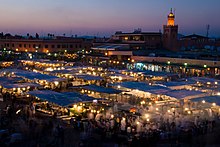North Africa is the Northern part of the African continent.
Countries

| Algeria (Algiers) The largest country in Africa. |
| Egypt (Cairo) Home of the ancient Egyptian civilization, with its temples, hieroglyphs, mummies. |
| Libya (Tripoli) Large open spaces with more than 90% of the country being desert or semidesert. |
| Morocco (Rabat) Situated on both the North Atlantic Ocean and Mediterranean Sea. |
| Tunisia (Tunis) Located in the very centre of Mediterranean Africa |
| Western Sahara Governance is in dispute between Morocco and Sahrawi Arab Democratic Republic (SADR), but the majority of the region is occupied by Morocco. |
Other territories
Atlantic Ocean Islands: Canary Islands (Spain), Madeira Islands (Portugal)
Spanish Exclaves: Ceuta, Melilla
Cities

- Alexandria — Egypt's major Mediterranean city is a pale shadow of its former glorious self but remains a major tourism site
- Algiers — the capital of Algeria with a notable medieval casbah
- Cairo — the largest city in Africa with major monuments of Ancient Egypt nearby
- Casablanca — the largest city in Morocco is of sparse interest to the traveller, but is a major transit point
- El Aaiún — the capital city of the disputed territory of Western Sahara
- Marrakech — this historic Moroccan city close to the foothills of the Atlas Mountains is an extraordinary meeting of the ancient and modern
- Tripoli — Libya's capital was long off-limits to most travellers but is experiencing a real resurgence of interest
- Tunis — the capital of Tunisia is a relatively small and sleepy city but is the gateway to the remains of Carthage and other very notable historical sites.
Other destinations

- Abu Simbel — a very remote area in far south Egypt, with some beautiful ancient temples
- Carthage — Phoenician colony in Tunisia and the biggest trade metropolis of the antique world; famously razed by the Romans and the remnants are now encased in a museum
- El-Oued — in Algeria with its domed architecture & nearby Grand Erg Oriental — the Sahara's second largest dune field
- Ghat - an ancient settlement in southwest Libya with prehistoric rock paintings and very challenging desert trekking
- High Atlas — hiking, skiing and Berber culture amongst these peaks and valleys in Morocco.
- Leptis Magna — extensive Roman ruins in Libya
- Matmata — desert village in Tunisia of cave abodes, where Star Wars's Tatooine was filmed
- Merzouga and M'Hamid — from either of these two settlements in Morocco at the edge of the Sahara, ride a camel or 4x4 into the desert for a night (or a week) among the dunes and under the stars
- Valley of the Kings — the great site of Ancient Egypt
Understand
|
Ramadan Ramadan is the 9th and holiest month in the Islamic calendar and lasts 29–30 days. Muslims fast every day for its duration and most restaurants will be closed until the fast breaks at dusk. Nothing (including water and cigarettes) is supposed to pass through the lips from dawn to sunset. Non-Muslims are exempt from this, but should still refrain from eating or drinking in public as this is considered very impolite. Working hours are decreased as well in the corporate world. Exact dates of Ramadan depend on local astronomical observations and may vary somewhat from country to country. Ramadan concludes with the festival of Eid al-Fitr, which may last several days, usually three in most countries.
If you're planning to travel to North Africa during Ramadan, consider reading Travelling during Ramadan. |
North Africa, as a region is very different from the countries to the South. The people and culture are Arabic, the food is different, and Islam is the dominant religion. Many organizations now group North Africa and the Middle East together as MENA (Middle East North Africa) because North Africa has much more in common with countries like Syria or Jordan than countries like Mali or Ivory Coast.
History
Talk
Arabic is without a doubt the dominant language, and is the official language in every North African country. However Arabic dialects are mutually unintelligible, so there's no way a tourist speaking standard Arabic could understand a Moroccan speaking his dialect. However, standard Arabic is always the official language, and with the exception of Western Sahara, almost all urban people are able to speak it.
French is the most widely known second language in Tunisia, Algeria and Morocco, due to much of the area's history as a French colony. In Libya and Egypt, English is the dominant second language (except among older Libyans, where Italian is more prevalent)
Many people in North Africa, especially in Algeria and Morocco, speak Berber as their first language.
Get in
By boat
There are some ferries from Italy, notably Sicily and also the Canary Islands.
See Ferries in the Mediterranean.
Get around
See

Itineraries
Do
Eat
North African cuisine has a lot in common with the Middle Eastern cuisine.
Drink
Stay safe
Avoid drinking untreated ground water.
Go next
